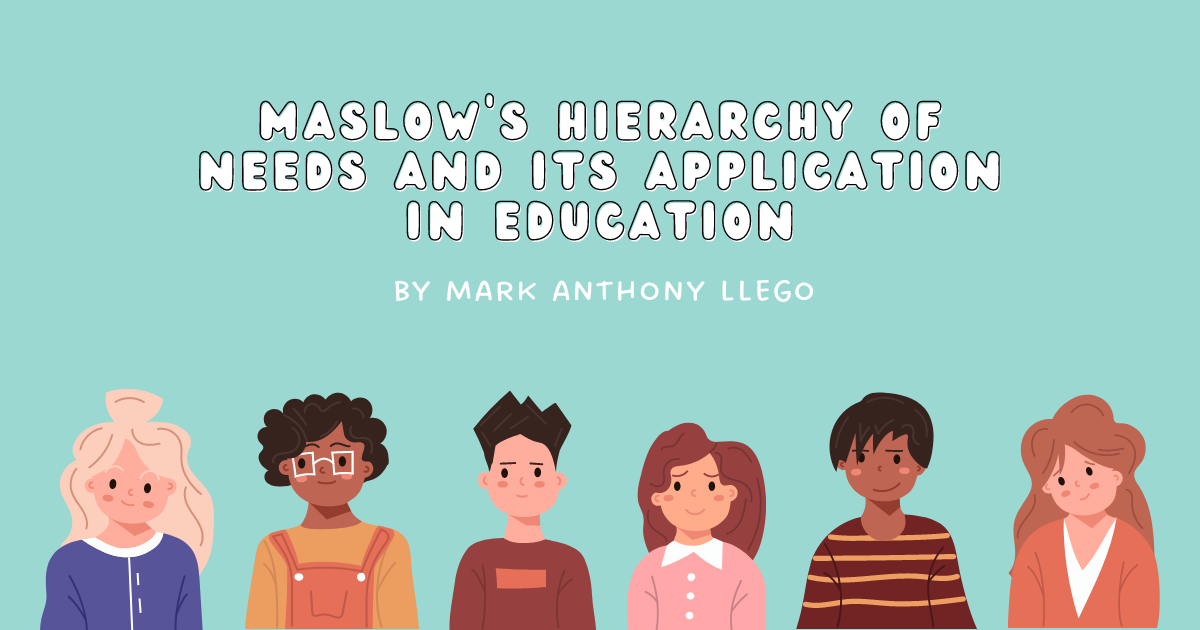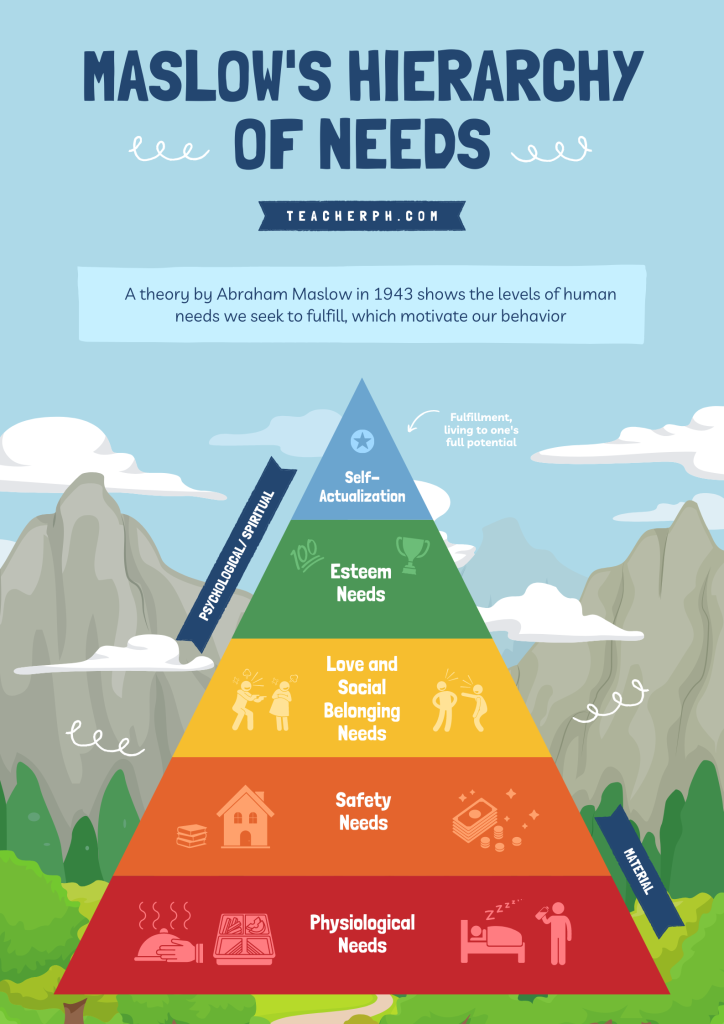
To be successful in any field, it is vital to have a strong foundation. This is especially true for the field of education, where students must learn the basics before moving on to more advanced concepts.
However, due to poverty or other factors, many students do not have access to a good education. To help these students, educators need to be aware of the different needs that students have.
Maslow’s hierarchy of needs can be used as a tool to understand these needs and create a more supportive learning environment for all students.
Table of Contents
Maslow’s Hierarchy of Needs
Psychologist Abraham Maslow first proposed the hierarchy of needs in his 1943 paper “A Theory of Human Motivation.” The theory is based on the idea that there are certain needs that all humans must satisfy to reach their full potential.

The theory divides human needs into five categories: physiological, safety, love and belonging, esteem, and self-actualization.
The first level of Maslow’s Hierarchy of Needs is physiological needs. These are the basic needs that all humans have to survive, such as food, water, and shelter. In a classroom setting, it would include ensuring students have access to healthy food and adequate breaks throughout the day.
The second level of Maslow’s Hierarchy of Needs is safety needs. These are the needs that humans have to feel safe and secure. It would include creating a safe and welcoming environment for all students in a classroom setting.
The third level of Maslow’s Hierarchy of Needs is love and belonging. It is the need that humans have to feel loved and accepted. It would include ensuring that all students feel like they belong and are appreciated in a classroom setting.
The fourth level of Maslow’s Hierarchy of Needs is esteem. It is the need that humans have to feel good about themselves. It would include providing opportunities for all students to succeed and be recognized for their accomplishments in a classroom setting.
The fifth and final level of Maslow’s Hierarchy of Needs is self-actualization. It is the need that humans have to reach their full potential. It would include providing opportunities for all students to explore their interests and develop their talents in a classroom setting.
Maslow’s Hierarchy of Needs and Its Application in Education
Maslow’s hierarchy of needs (1943) is a theory that can be applied in the field of education to help educators understand the different needs that students have and how to meet them best.
For example, suppose a student is struggling in school. In that case, it may be because they are not meeting their basic physiological or safety needs. In such cases, it may be helpful for educators to provide the student with some necessities or a sense of security to help them focus on their schoolwork.
On the other hand, if a student is excelling in school but is not meeting their social or esteem needs, it may be helpful for educators to give them more opportunities to socialize or praise them for their accomplishments.
Finally, suppose a student is meeting all their needs but is not yet reaching their full potential. In that case, it may be helpful for educators to encourage them to continue growing and exploring new opportunities.
The Different Needs That Students Have and How to Meet Them
One way that educators can use Maslow’s hierarchy of needs is by understanding what kind of needs their students have and then catering their teaching methods to meet those needs.
First, suppose a student is having trouble paying attention in class. In that case, it may be because they are not meeting their need for safety or belonging. In this case, the educator can work to create a more safe and more nurturing environment for the student. They can also help the student connect with other classmates or activities outside of school that will help them feel more connected and supported.
Second, if a student is not meeting their basic physiological needs, such as having enough food or water, then they are not going to be motivated to learn. On the other hand, if a student feels safe and secure, they are more likely to be open to new ideas and willing to try new things.
Third, if you have students who are motivated by the need for belongingness, you can create a supportive classroom environment where everyone feels like they belong. And if you have students who are motivated by the need for self-actualization, you can challenge them with rigorous coursework that will help them reach their full potential.
Last, educators can use Maslow’s hierarchy of needs is by using it as a guideline for creating lesson plans. By taking into account the different levels of need, educators can create lessons that will engage and motivate their students. For instance, lessons that focus on self-actualization needs, such as helping students discover their talents and potential, are more likely to inspire students than those that only focus on lower-level needs.
Meeting students’ needs can help them learn and grow in many ways. It can improve their academic performance, increase their motivation to learn, and engage them more in class. It can also help them build stronger relationships with educators and classmates, leading to a more positive school experience overall.
How Educators Can Improve Their Teaching Methods by Utilizing Maslow’s Hierarchy of Needs
How educators can use Maslow’s hierarchy of needs to improve their teaching methods:
- Educators can first become familiar with the different levels of Maslow’s hierarchy of needs.
- Once they are familiar with the different levels, educators can then begin to use it as a tool to improve their teaching methods.
- By understanding what motivates students at different levels, educators can create lessons and activities that better meet the needs of their students.
- In turn, students will be more engaged and motivated in their learning, leading to better academic outcomes.
- Ultimately, using Maslow’s hierarchy of needs can help educators to create a more effective and efficient learning environment for their students.
Here are some examples of how educators have applied the theory to improve their teaching methods:
Educators have used Maslow’s theory to improve their teaching methods by understanding students’ different needs. For example, educators can use the theory to help them understand why some students are motivated to learn while others are not.
In addition, educators can use the theory to help them understand why some students struggle in school. For example, students may struggle because they are not meeting their self-esteem or belongingness needs. By understanding the reasons why students are struggling, educators can work to address these issues and help the students succeed.
Conclusion
Maslow’s Hierarchy of Needs provides a framework for understanding how people meet their needs. The theory can be used to improve teaching methods by helping educators understand what motivates their students. By understanding what students need to meet their needs, educators can create a classroom environment that is conducive to learning.
The theory can also be used to help students set goals and achieve them. When students feel motivated and supported, they are more likely to succeed in school.
Ultimately, Maslow’s Hierarchy of Needs can help educators create a positive learning environment for their students.
No matter what your student’s needs are, you can use Maslow’s hierarchy of needs to improve your teaching methods and help your students succeed.
Do you have any students who are struggling to meet their basic needs? If so, what resources can you connect them with?
Do you have any students who are motivated by the need for belongingness? If so, how can you create a supportive classroom environment for them?
Do you have any students who are motivated by the need for self-actualization? If so, how can you challenge them with rigorous coursework?
How to Cite this Article
Llego, M. A. (2022, August 29). Maslow’s Hierarchy of Needs and Its Application in Education. TeacherPH. Retrieved August 29, 2022 from, https://www.teacherph.com/maslows-hierarchy-of-needs-education/
READ MORE:
Action Research in Education: What You Need to Know
Top Scaffolding Strategies to Use With Your Students
Benefits of Inclusive Education for All Students
Top Qualities of an Effective Teacher
How Does Education Contribute to Community Development
Importance of Physical Education Classes
How Quantitative Research Can Help Senior High School Students
Differentiated Instruction: A How-To Guide for Teachers
An inspiring piece of write up
Thanks for sharing. very helpful.
Awesome, really helpful